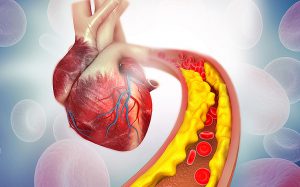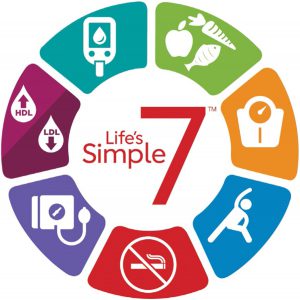Reading time: Approximately 6 minutes
This is the first of a four-part series on the leading cause of death in both USA and Marion County, FL. I’ll start by posing some questions.
Q: What is the # 1 cause of premature death among men and women in the United States and Marion County?
A: It is heart disease. Heart disease is a term that refers to several diseases that afflict the heart. Atherosclerosis or coronary artery disease is the most common type of heart disease, and by far the main cause of death in the United States (CDC, 2021). Atherosclerosis refers to the “hardening” and obstruction of the arteries due to plaque build up. Plaque is made up of deposits of “bad” LDL cholesterol.

Credit: Rasi Bhadramani /iStock /Getty Images
Q: How many people die each year due to heart disease?
A: For the US: About 659,000 people, (CDC, 2021). In Marion County, FL: Around 6,513 people from 2013 – 2017. Shockingly, the afflicted start dying by age 18 (Well Florida Council, 2019). Isn’t that a lot!? A personal aside: I lost my paternal grandfather to heart disease when he suffered a sudden heart attack. His death was devastating for my dad and the entire family. We can, however, avoid such tragic family stories simply by transitioning to a healthier lifestyle. Heart disease cost the U.S. government and we taxpayers around $ 363 billion dollars each year, according to CDC figures for 2016 and 2017 (CDC, 2021).
COUNT YOUR RISK FACTORS BELOW:
By this point, I imagine you’re wondering what causes heart disease and how we can prevent it. Actually, there are behavioral and health factors that might put you at a higher risk of developing heart disease.
The behavior factors are:
- smoking,
- lack of physical activity,
- poor diet, and
- being overweight or obese
And the health factors are:
- high cholesterol,
- high blood pressure,
- and having diabetes

Credit: American Heart Association, retrieved from Virani, et., at.
These factors are represented in the illustration below. By understanding and gaining better control of each of these seven factors, your risk of developing heart disease will DROP!
Keep a balanced diet: The most powerful contributor to atherosclerosis, the hardening and obstructions of your arteries, is “bad” cholesterol. (My next post will dive deeper into cholesterol and fats. Stay tuned! Subscribe here.
Achieve a more healthful body weight: There is a direct relationship between your weight and your health. Click here to calculate your body mass index (BMI) and find out if you are in a weight category that may lead to health problems.
Become more physically active: Here are a list of Marion County, FL parks you can visit to increase your physical activity, and, at the same time, enjoy the bounty of nature in the area…
Do you Smoke? Smoking increase the build up of plaque learn more here. Click to quit here.
When was the last time you had your blood pressure measured? What are your cholesterol levels? Schedule a test. A combination of low HDL “good” cholesterol, with high LDL “bad” cholesterol + high triglycerides (a type of fat) increases your risk of heart disease.
Manage your diabetes: High blood sugar can damage the vessels and nerves in your heart. To find a diabetes education program in your area, click here.
SOME FINAL THOUGHTS
Now that you know your risk factors, don’t you agree WE CAN control most, if not all of them? Can we agree that heart disease is mostly a lifestyle disease? There are some exceptions, since some individuals are born with the condition (CDC, n.a.). By looking at the above image, you can see that if we have a balanced diet, we will control at least four other factors –– namely weight, cholesterol, blood pressure, and diabetes. Building a healthful meal is the most powerful prevention tool against heart disease. (To learn more about preventive nutrition, please follow this blog to see my next posts.)
Now, wait, what about genetics? Well, even if you do carry a genetic predisposition to develop a chronic disease, your lifestyle will ultimately determine whether such genes will be expressed, meaning activated. As an anonymous author said long ago, “Genetics loads the gun, but lifestyle pulls the trigger.”
![]() TAKE AWAY: We can “kill the number one killer” simply by adhering lifestyle changes. We can change the statistics, and it starts in our kitchens and can be seen on our plates. Good nutrition will decrease most of the risk factors associated to the development of heart disease. Genetics does not dictate our future, and we, as part of a human species, were designed to age healthily and free of chronic diseases.
TAKE AWAY: We can “kill the number one killer” simply by adhering lifestyle changes. We can change the statistics, and it starts in our kitchens and can be seen on our plates. Good nutrition will decrease most of the risk factors associated to the development of heart disease. Genetics does not dictate our future, and we, as part of a human species, were designed to age healthily and free of chronic diseases.
![]() REFLECTIONS: What am I going to do differently from now on? Please share on the comment below any small steps are you going to take to decrease your heart disease risk. By doing this, you are also inspiring other readers!
REFLECTIONS: What am I going to do differently from now on? Please share on the comment below any small steps are you going to take to decrease your heart disease risk. By doing this, you are also inspiring other readers!
![]() COMING NEXT: Killing the # 1 Killer Series – Part 2: From your plate to your heart – understanding unsaturated fats. To get notified about the next posts, please subscribe here.
COMING NEXT: Killing the # 1 Killer Series – Part 2: From your plate to your heart – understanding unsaturated fats. To get notified about the next posts, please subscribe here.
Thanks for reading, and here’s to better health!
Rebecca Elliott
References
Centers for Disease Control and Prevention. (2021). Heart Disease facts. Retrieved from https://www.cdc.gov/heartdisease/facts.htm
Centers for Disease Control and Prevention. (n.a.). Know the facts about heart disease. Retrieved from https://www.cdc.gov/heartdisease/docs/ConsumerEd_HeartDisease.pdf
Virani, S. S., Alonso, A., Aparicio, H. J,, Benjamin, E. J., Bittencourt, M. S., Callaway, C. W., et al. (2021, January). Heart disease and stroke statistics—2021 update: a report from the American Heart Association external icon. Circulation, 143: e254–e743. https://doi.org/10.1161/CIR.0000000000000950
Well Florida Council. (2019). 2019 Marion County Community Health Assessment, Page 660. Retrieved from http://www.floridahealth.gov/provider-and-partner-resources/community-partnerships/floridamapp/state-and-community-reports/marion-county/_documents/Marion_CHA.pdf
 1
1

Comments:
February 2, 2022
Dear reader, Thank you for your feedback! I have more posts coming up soon. Plase stay tuned. If you wish to participate in our classes on nutrition and healthy lifestyle, feel free to sign up to my next class using the following link: https://www.eventbrite.com/e/healthy-for-life-series-1-live-session-5-virtual-sessions-tickets-243082485257?aff=eprofsaved All the best, Rebecca
February 1, 2022
Hi there Rebecca Very nice content and blog, I found it very informative and useful, hope to read more nice articles like this one around here, Keep sharing the best content, Best regards! Your follower Salvatore Cataratas
November 16, 2021
You are welcome, Catherine! Please subscribe to be notified of my next posts. Take care, Rebecca
November 16, 2021
Wonderful tips! Thanks for sharing!
November 16, 2021
Thank you! I hope you can implement some of these tips. Stay tuned for my next posts. Take care, Rebecca
November 16, 2021
Thanks for these suggestions I'll think about while shopping for our big holiday meal. We did try a tofurkey loaf last thanksgiving and everyone enjoyed it, but i didn't know about some of these other substitutions to helpmy health
November 16, 2021
Very well prepared and healthy list diet! Thank you Rebecca!
November 12, 2021
Thank you eericdw07! I'm very glad you are finding this information helpful! I hope you find the recipes tasty! Stay tuned for my next post next week! All the best, Rebecca
November 12, 2021
Hi, I really love to read your blog, it’s such a rich information, I particularly love two recipes above on the second video avocado in the egg and the last one avocado and strawberry... I hope learn those recipes for keep a good health and have a wonderful thanksgiving.. well it’s going to be one more thing to be thankful for .
November 12, 2021
“What was your favorite recipe?” “Do you intend to cook any of them?” “Do you intend to include any of the unsaturated rich foods in your diet?”
November 9, 2021
Hello Lamont, Thank you for your comment, and I'm sorry about your father. Improving your diet is a crucial step to preventing heart disease. Please subscribe to receive notifications on my next posts about diet and heart disease prevention. All the best, Rebecca
November 9, 2021
Thanks for this info! I don't smoke, but I can see I probably need to improve my diet. My pops died of heart disease last year!
April 7, 2021
The researchers I talked to believe it is any kind of oak, at least the kinds that grow here in Florida. Our oaks will hybridize and it can be difficult to tell them apart. They believe there is some antibacterial property in the oaks that helps the citrus overcome HLB. They are not sure what it is, so research continues. It could be some type of peptide like that found in finger limes that also has antibiotic properties and is being developed for HLB therapy. It could also be that the oaks create a healthier soil microflora that allows the trees to resist HLB. Research will tell, but it is something that homeowners can try now before we know exactly how it works.
April 7, 2021
You mentioned Laurel Oak in your article. My property in Fort Pierce has several different oak varieties, and although I am not certain which varieties they are, I have heard them referred to as Live Oak and others as Scrub Oak. Are these leaves also believed to be beneficial in trying to counteract the effects of HLB in citrus?
February 1, 2021
You can grow native persimmons or Kaki persimmons. Kaki persimmons are more popular because there are non-astringent types which can be eaten firm or soft. Many nurseries provide Kaki persimmons. More information about growing persimmons can be found at https://edis.ifas.ufl.edu/topic_persimmon. Popular cultivar information about which cultivars to grow can be found at https://edis.ifas.ufl.edu/mg242. A local nursery near you that provides persimmons is Chestnut Hill, https://chestnuthilltreefarm.com/product-category/fruit-oak-trees/persimmon-trees/, but you need only search online for Kaki persimmon to find more.
January 30, 2021
Hello, please give information where we can buy persimmon tree? And which kind is good for Marion County. Thank you, Tasha
April 22, 2020
The blueberry gardener's guide at https://edis.ifas.ufl.edu/mg359 provides some guidance on the amount of water blueberries need at various times of year. It depends on your soil type, the blueberry being grown, and the environmental conditions.
April 20, 2020
Whats a typical bluenerry water use curve in South Florida?
April 13, 2020
The research was done on plots without crops, so there was no comparison of yields. Vinegar works by burning back leaves on contact, so great care should be taken when using around crops. Glyphosate is translocated within the plant to kill weeds and even greater care should be taken when using that around crops.
April 12, 2020
How did the crop outputs fair with the different applications? Was the crop yield less with some because of the intensity of the application? Could you use an application to control weeds within the crop growing peruod? I am a strong adcocate against "Roundup"! I don't even know why it is still legal to use. I know of a farm that uses a combination of powerful weed killers (obviously not organic) and the overspray floats over to a horse pasture and burns their grazing grass.
Comments are closed.